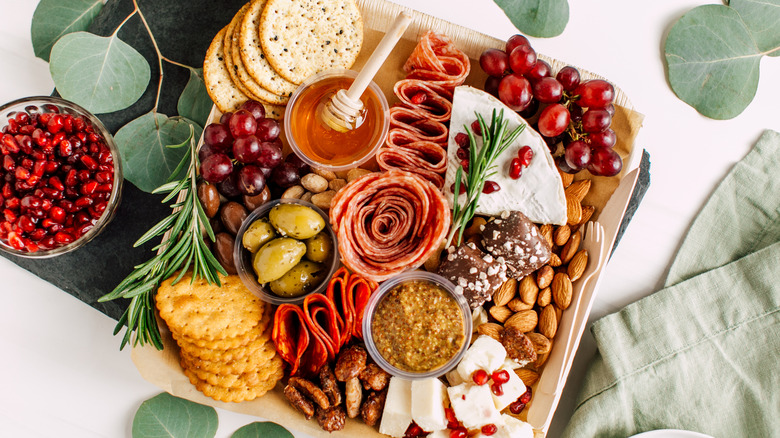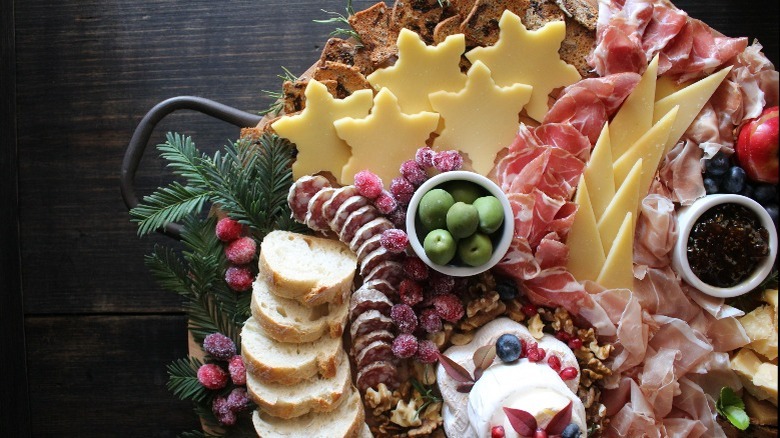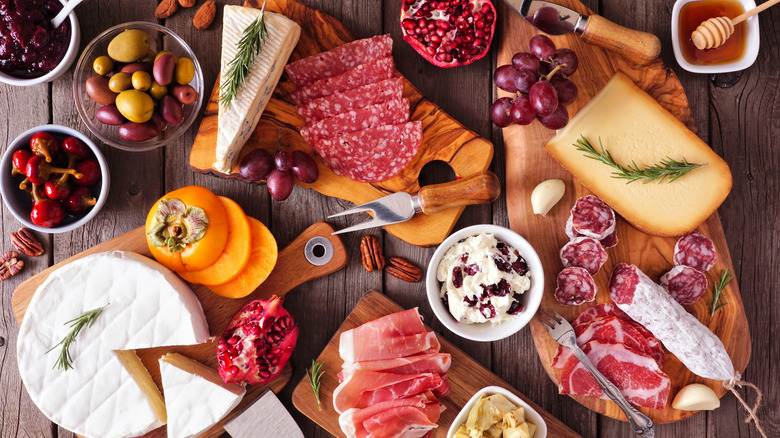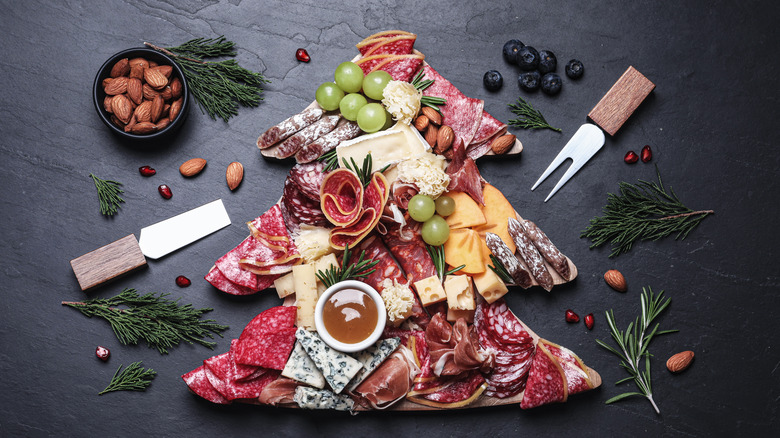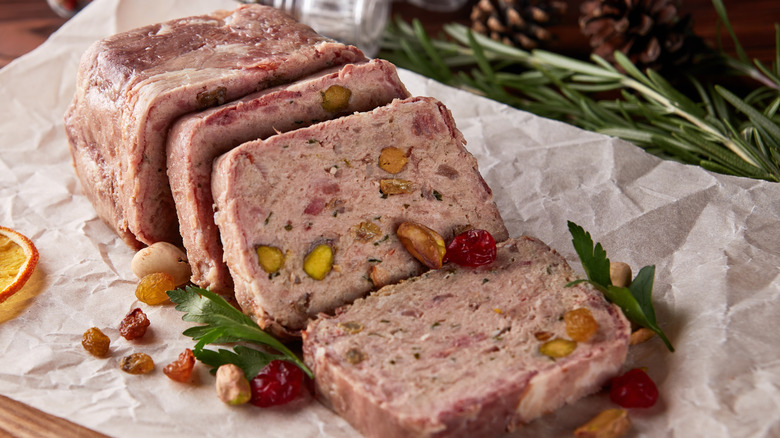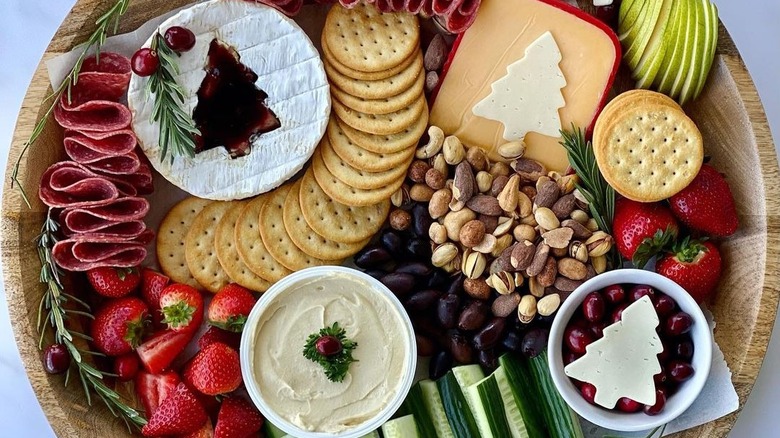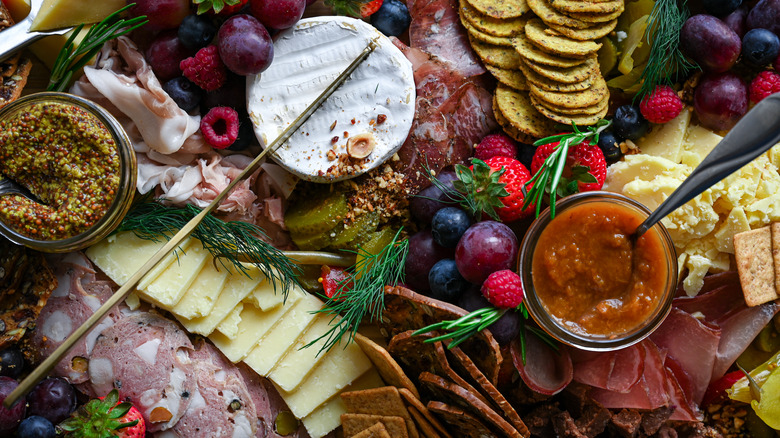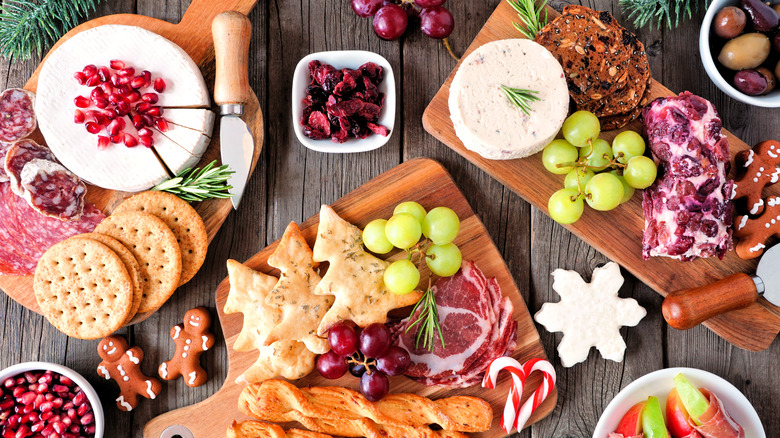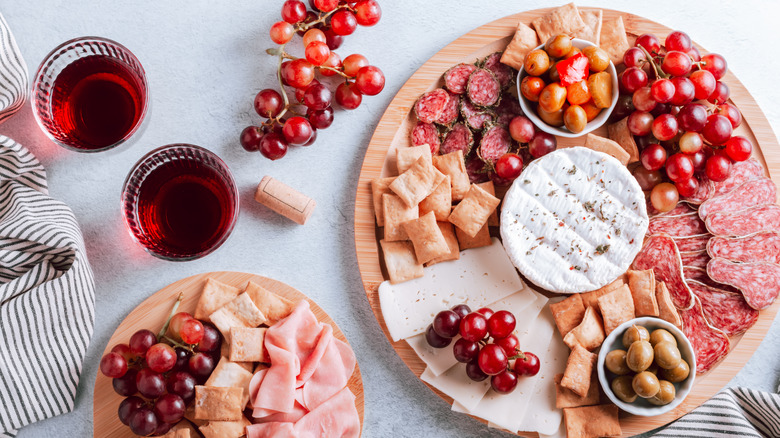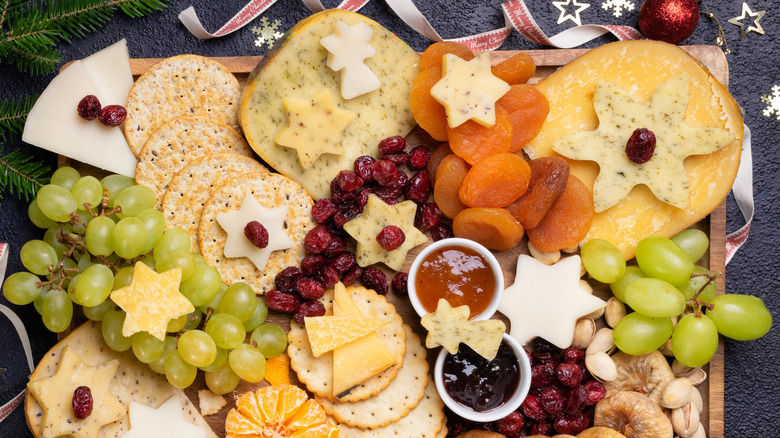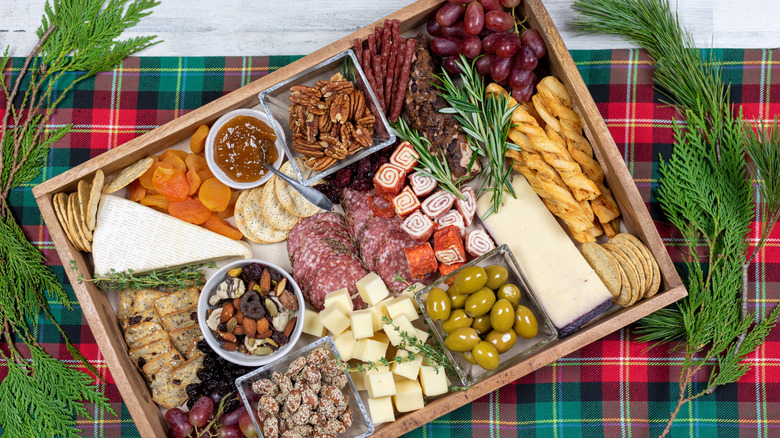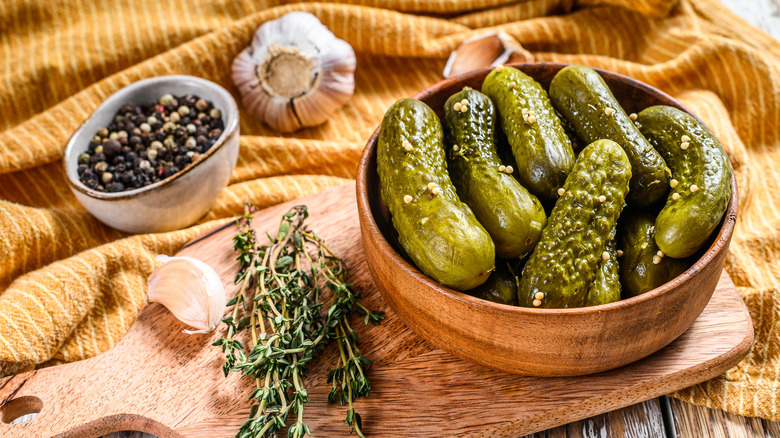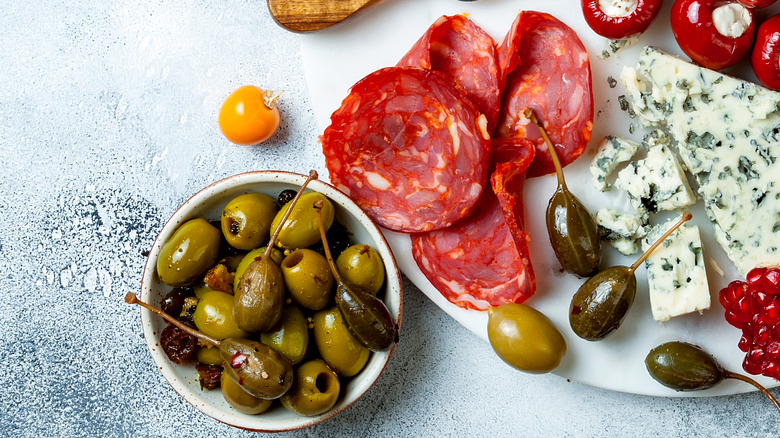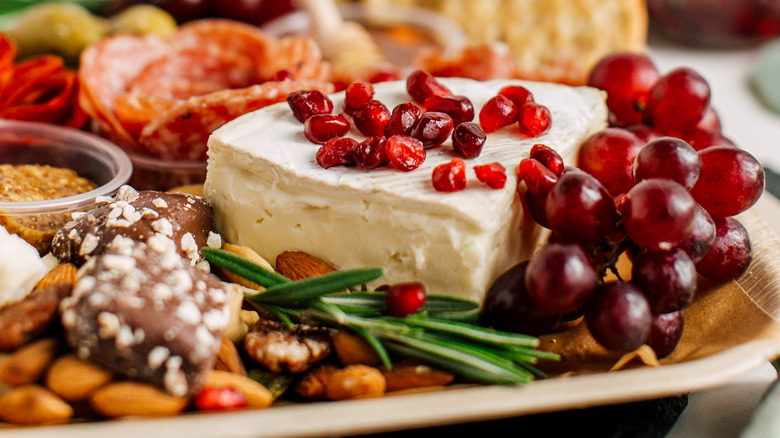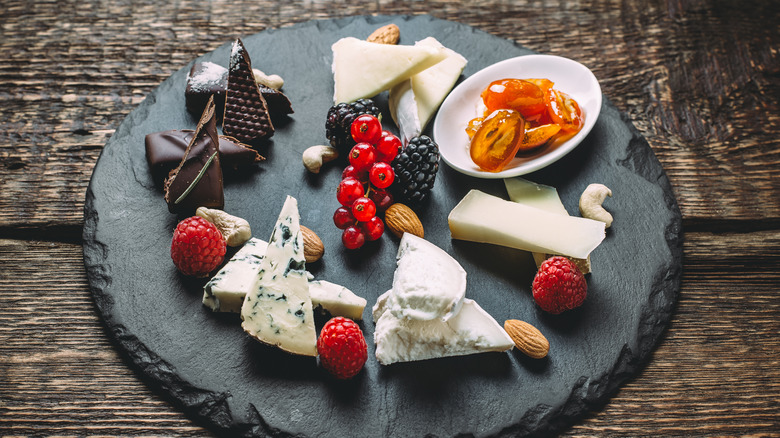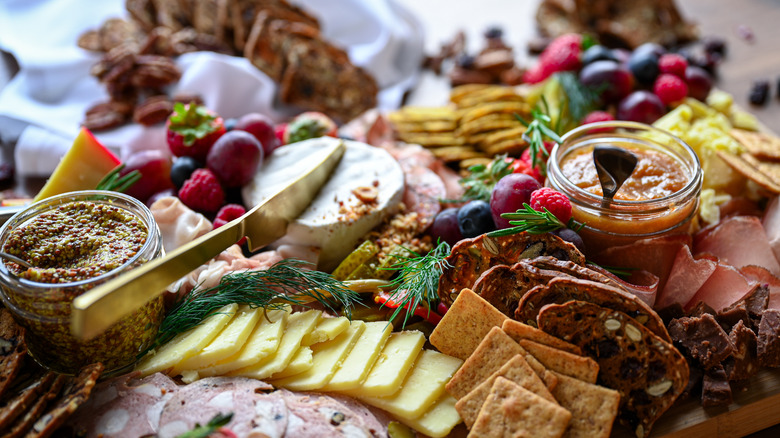Must-Have Items For Your Christmas Charcuterie Board
Are you hosting a holiday party, looking for an easy but impressive way to feed your family after an epic cookie baking session, or craving a festive snack for your Christmas movie marathon? A Christmas charcuterie board is the perfect centerpiece in every case. Putting it together is less complicated than it looks, and any excuse to feast on assorted meats and cheeses with all the accompaniments is a good one.
Striking the ideal balance of flavors and textures is easy once you know a few pro tips. Making it into a holly jolly Christmas charcuterie board is mostly a simple matter of prioritizing color and seasonal produce. The idea is totally scalable for any size gathering too, even if it's just a charcuterie plate for Santa (aka, you). Depending on how big and elaborate you want to get with your spread, you may need more than one actual board, platter, or plate. If you arrange them close together, they still work as a unified smorgasbord.
A couple of other options are to arrange a Christmas charcuterie tree or a Christmas charcuterie wreath. Both look amazing even if you use a smaller variety of cheese, meat, and garnishes — and they're far easier than a structurally sound charcuterie chalet.
No matter how large — or small — you're going, just make sure to grab these must-have items for your Christmas charcuterie board and things are guaranteed to be merry and bright ... and delicious, of course.
Hard cheeses
While the word charcuterie refers to meat alone, no modern charcuterie board is complete without at least a few good kinds of cheese. Generally speaking, you'll want between two and five ounces of cheese per person — lean toward the higher end of that range if the charcuterie board is intended to be the main event — and you should assemble a few different types that represent multiple textures as well as tastes.
In the hard cheese category, Cooking with Cocktail Rings shares the sage advice to "serve at least one cheese that people are familiar with" so even picky eaters can (and will) dive right in. Classic Parmesan or a firm cheddar both fit that bill. A rich, aged Gouda is another safe bet. Other good options include nutty gruyere, salty manchego, and mild Colby cheese.
If you start with large and thin enough slices of very firm cheese, you can use mini cookie cutters to create festive shapes like trees and stars, as Food, Pleasure and Health adorably demonstrate.
Even if you don't get that cute, it's a good idea to cut your hard cheeses into cubes or triangles before placing them on the board, and let them come to room temp so the texture and taste aren't dulled by the lingering chill of the fridge.
Soft cheeses
To balance out the hard cheeses, you'll want to pick one or two softer varieties too. As it happens, there are lots of soft cheeses that also look appropriately festive in green and red, like cranberry-speckled Wensleydale, herb-flecked Boursin, marinated bocconcini (as spotted on The Toasty Kitchen's charcuterie plate), and goat cheese logs rolled in ruby-red dried cranberries or green herbs.
While not everyone is a fan of mild-yet-mushroomy brie, if you are, a Christmas brie is another fabulous touch. Food stylist and blogger Meg Quinn's method for making one is to pop the soft cheese wheel in the freezer just until it's firm enough to push a cookie-cutter cleanly through the middle. Fill the center shape with a brightly colored ingredient like pomegranate seeds, and use the cut-out portion of cheese to adorn another area of the board. Let it sit at room temp long enough to get runny again. Granted, things will get messier once people start cutting in, but it's an easy and effective flourish that makes your charcuterie plate instantly Instagram-ready.
Looks aside, other top contenders for the soft cheese portion of the proceedings include creamy blue cheese (which can be surprisingly sweet and mild if you're not a fan of sharp and pungent varieties), feta, and burrata.
Sliced meats
A charcuterie board without meat is just a fancy cheese plate, and there's nothing wrong with that! But for omnivores, the animal protein is an essential element — and the choices are astounding. But don't let the prospect of what kind of meats to put on a charcuterie board overwhelm you. As with your cheese selection, the key is to offer a few different types of textures and tastes.
Soft slices of prosciutto or jamon nestle up nicely next to firmer cured sausages, and both happily share space with chewier salami, in slices and/or nuggets. While some people like to provide a knife for everyone to slice their own, you'll save space on your board and make things easier by pre-cutting whole salamis and sausages into bite-size pieces yourself. In addition to texture, pay attention to flavor and aim for a mix of mild and salty with smokier and sharper notes.
When it comes to how to arrange them on the board, Food52 has some tips on styling charcuterie. Those eye-catching meat roses and salami rivers are easier than you might think. For smaller coins cut from pencil-thin salami, overlap them like shingles to save space and look fancy.
Plan on roughly the same amount as cheese: between two and five ounces of meat per guest (you can squeak by on the lower end if you're serving other dishes too).
Pâté or terrine
When it comes to soft meats, many people's minds may automatically go to velvety cured ham or even deli slices, but often-overlooked (and completely optional) pâté or rillettes can be a great addition to a charcuterie board.
You can make your own meat mousse, or buy a ready-made version. Check the fancy cheese counters at stores like Whole Foods, or order online from places like Olympia Provisions, D'Artagnan, and Murray's Cheese. If you like spice, keep an eye out for the spreadable Italian 'nduja too, which happens to be deep red in hue.
In the same family of preserved meat preparations, terrines tend to be firmer in texture but can also be a nice bridge between creamier cheeses and drier salamis. Plus, they can look especially festive for the occasion, like this homemade cranberry and pistachio pate from Foodie on Board. Try making it in smaller silicone molds like the ones intended for baking and chocolate — making it easier to get daintier slices for your board.
A creamy spread or dip
When you're wondering what spreads to put on a charcuterie board, you're probably thinking along the lines of condiments, and those are certainly essential — but first, a word on dips.
If you have a super-runny, ultra-creamy cheese already, and/or a spreadable meat product, this is a less critical component, but it is undeniably lovely to provide some sort of especially luscious substance on your charcuterie board. Since this is Christmas, you get major bonus points for dips that are naturally tinted red or green. Consider swirling cream cheese with pesto for a quick, herby dip, make a cold spinach artichoke dip (easier to incorporate as opposed to one you need to serve warm), or try a sundried tomato dip.
Or, just go with what you love, like a classic caramelized onion dip or crowd-pleasing everything bagel dip and scatter some minced sundried tomatoes and fresh green herbs on top to garnish with a little holiday flair. As with your cheeses, you should let your dip or spread come to room temperature so it's not too cold and stiff to slather or scoop.
Condiments
To complement and provide piquant contrast to your meats and cheeses, you'll want to include at least one kind of condiment on your charcuterie board. This could be something that marries sweet, sharp, and savory flavors in one bite, like this mulled wine cranberry chutney from Sainsbury's, or a store-bought mostarda or pepper jelly. Or, you can put out tiny pots of mustard (something grainy is a good choice) and honey — even a chunk of golden honeycomb on a miniature plate.
Use ramekins or your smallest bowls to hold these extras, and be sure to provide separate utensils for each one, preferably equally petite so they stay put and don't get in the way of other ingredients on the board. For honey, a wooden drizzle stick is a nice touch, but if using a piece of comb, a small cheese spreader knife is best.
If you're not a big fan of honey, then fruit jams, jellies, and preserves are equally good partners for many types of meats and cheeses, and provide a similarly sweet counterpoint to sharp mustard, with the added bonus of being less likely to drip all over the rest of the board.
Crackers and carbs
To provide a solid base for all the other elements you assemble, at least one or two bready items are de rigueur. Crackers are the classic choice and are always welcome, but very small rounds of toasted bread from a slim baguette are a nice touch too. Try to hit the same goal here of offering more than one taste and texture — for instance, pick at least two different types of cracker, like a buttery club cracker and a crunchier seeded variety.
Those dark crackers studded with cranberries and pistachios that are often found above the cheese case (or at Trader Joe's) add a certain richness both visually and otherwise, but they can be too much for the texture-averse. In that case, a nice herb-flecked cracker still looks festive. The Cheese Professor got some expert recommendations for specific brands of store-bought crackers to seek out.
If you want to go the extra mile, try making homemade crackers that can be shaped with mini cookie cutters into Christmas trees, candy canes, and snowflakes. This cheddar cheese cracker recipe from Bakepedia will work wonderfully. Or, try easy parmesan pesto twists, which Jo Cooks makes with store-bought puff pastry (try half with basil pesto and half with sundried tomato pesto for Christmas colors).
Fresh seasonal fruit
Fruit is another crucial component of a great charcuterie board, so choose wisely. Strawberries and raspberries might look cheerful, but are not likely to taste good in the winter. Luckily, many flavorful, in-season fruits do still bring colorful touches to the table.
Seek out a few different types of ripe apples and pears. If you're lucky enough to find a variety of red-fleshed apple, like Lucy Glo (sweet yet tart, with a berry-like flavor and naturally pinkish-red flesh inside), definitely snap some up, but don't sweat it if not. Red grapes are another perfect charcuterie board fruit, and still tend to be bursting with flavor post-fall. Ditto pomegranates, though they're nigh impossible to actually eat unless you remove the seeds ahead of time and serve them in a small bowl on the board.
To instantly elevate your board, make a batch of sugared cranberries like blog Number 2 Pencil suggests. These shimmering tidbits are still quite tart, but with enough sweetness to make them palatable, and are a great match for many creamy cheeses and savory meats. Though they don't conform to a red-white-and-green theme, melting-soft, honey-sweet persimmons are another underrated option.
As for what not to put on your charcuterie board, citrus can be tricky; as Cup of Zest points out, its inherent acidity makes it difficult to pair with many cheeses. While blood orange wheels might look amazing among all the other ingredients, they'll clash in flavor, and taste is the most important factor here.
Seasonal dried fruit
While fresh fruit adds all-important juiciness, sweet-tart notes, and a range of crisp, soft, and tender textures, don't forget about dried fruit for filling out your charcuterie board — literally, in some cases. Smaller dried fruits in particular can be useful for physically filling in gaps on the board between other ingredients, but they're not just for show.
Dried cranberries and cherries are pleasantly chewy and tart, as are slightly stickier and sweeter golden raisins. If you find flame raisins, their deep reddish shade is especially nice for a color-coordinated board. Dried figs bring a subtle, seedy crunch. Shatteringly crisp apple and pear chips can even act as sweet stand-ins for crackers as people build their bites.
Dixya Bhattarai of Food, Pleasure, and Health likes to stuff dates with goat cheese and pumpkin seeds for a multi-textured punch of sweet-salty flavors all in one bite on her board.
When deciding on which dried fruit to add, if there's anything you're unlikely to finish up in other applications, take the advice of Fav Family Recipes and buy small quantities from your store's bulk bins instead of an entire pre-packed box or bag.
Roasted nuts
As long as none of your nibblers are allergic, nuts are a must-add element for your charcuterie board. Almost any kind will work, but don't give guests a raw deal. Roasted or toasted nuts will be much crunchier and tastier, and you can buy almost any variety already prepared, plain or seasoned.
Spiced almonds provide a rich crunch and festive, herby flavor, but you can easily make your own roasted nuts at home, too. If you don't like pepper, pick another herb such as rosemary, (but if it's a more delicate one, mince it and add it only after the nuts are roasted and cooled).
Shelled pistachios are a nice, naturally green option that taste as good as they look, and cinnamon sugar pecans bring that warmly spiced holiday flavor almost everyone loves, while still melding well with many other items on the board. If you're looking for a nut on the sweeter side, candied pecans are a wonderful option and can be made in less than an hour.
Pickles
Some people like to include fresh vegetables on their charcuterie board, while others think all lightly blanched and raw veggies should stay in their lane (i.e. on a crudité platter). Most can agree, however, that something pickled is a perfect addition to any meat and cheese plate.
You can add whatever pickled vegetables you prefer, but if you can find them, bright red peppadews not only look amazing but taste incredible, sweet, sharp, and spicy all at once. Some stores stock jars of them with the other pickles, and some cheese counters sell them, either stuffed with parmesan or plain. Pickled cherry peppers make a fine alternative, though they don't taste quite the same (Cook's Illustrated says you'll miss out on a certain sweet complexity).
If you're going green, don't limit yourself to the usual pickled cucumbers, zucchini, or even green beans and artichoke hearts. These sweet pickled grapes with white wine vinegar and cinnamon are a delightfully unexpected addition that's also super easy to make. You can choose red or green grapes, but plan on giving them at least two days to marinate in the fridge before you serve them.
Olives
Similar to but certainly distinct from pickles, olives are also a stalwart charcuterie board member. Obviously, any green olive variety makes the most appropriately colored option. Classic pimento-stuffed olives bring a pop of red as well, but if you think they're too boring, go for marinated green olives that feature specks of red pepper and other flavorful ingredients.
Those pack-your-own olive bars are a prime place to find sophisticated blends that look and taste amazing, but if you don't have any luck, making marinated olives at home is really easy. This Fork in the Kitchen recipe marries briny Kalamata olives and milder Castelvetrano olives with rosemary, oregano, thyme, bay leaf, garlic, lemon zest, and red pepper flakes.
Any type of plain olive you buy will taste amazing given the same treatment — and you can play around with the specific combination of herbs and spices — but in any case, use an olive oil that tastes great on its own to ensure the best flavor in the finished dish. Also, allowing at least a week for the flavors to meld is best, so plan accordingly (but 24-48 hours will be enough in a pinch).
Festive garnishes
Once you've chosen your components, all that's left to do is arrange them. If that seems like the most daunting part, there are plenty of online tutorials and tips. Blog Mom on Timeout suggests paying attention to color and texture when deciding where to put each element and separating similar ones with contrasting ingredients. Other tips include placing your small bowls down first, as "they are great to lean crackers against, pile dried fruit next to, stack cheese by, etc." and adding fresh herbs as a finishing touch.
Seriously, don't forget the garnishes. For a Christmas charcuterie board, fresh rosemary is probably your best friend. It looks like pine needles, smells fantastic, and handily fills in any gaps in your board, or frames it nicely around the edges. While you won't be picking it up to nibble, every time someone brushes it, it sends up a wonderful fragrance that adds to the experience — and it's a sturdy herb, so once your board is barren, wash off the sprigs and save them to cook with later. Fresh thyme and fresh bay leaves also work well, but any woody or fluffy herbs are fair game.
Pomegranate is another favorite charcuterie board garnish. Broken-open pomegranate halves do look beautiful, but they can't be easily eaten. A better option may be to scatter individual seeds in strategic places, like Lexi's Clean Kitchen, or position clusters of arils you've already separated from the shell and pith like Damn Delicious did for a holiday cheeseboard.
Chocolate
Sweet elements in the form of fruit and honey are good ideas in any charcuterie spread, but whether you should put chocolate on a charcuterie board depends on all the rest of the ingredients you've assembled. In many cases, chocolate may clash with several other components; conversely, it can harmonize surprisingly well with unlikely partners like prosciutto. If you have room on your board and want to include it, dark chocolate is the best bet as it's more complex and less sugary than milk chocolate, but it's entirely up to you.
As cheese and chocolate tend to be easier to pair, if you have ovo-lacto vegetarians in attendance, a meat-free chocolate and cheese board can be an especially great option. Side note: a chocolate salami would be a perfect option here.
Ditching the meat does mean it will no longer technically be charcuterie, but it's your party, and you can break the rules if you want to. While we're on the subject of stretching definitions (and chocolate, too), it's also worth checking out the many so-called Christmas charcuterie boards that skew entirely sweet with cookies, candy canes, and other holiday treats.
Small spreaders
Obviously, most of what ends up on your charcuterie board will be edible, but one non-food item that makes a huge difference is the humble cheese spreader. This small, rounded knife is the perfect size for serving creamy cheeses that don't have enough structural integrity to be picked up on their own, as well as any and all condiments, dips, and spreads joining the party. For looser things like honey and preserves, very small spoons are also handy.
Full-size butter knives and other utensils will work in a pinch, but their length makes them more unwieldy and prone to falling out of place (and getting in the way of other elements).
If you plan on making Christmas charcuterie an annual tradition, it's worth investing in a set of small spreaders topped with wreaths and the like. Or consider a less figurative approach, like this cheeky little set of spreaders from Etsy. Their inscribed messages to spread love, joy, peace, and hope are certainly seasonally appropriate, but fit to use all year round as well.
Now armed with the knowledge of everything you need for the best Christmas charcuterie plate, you'll have no trouble pulling it off — and probably no trouble polishing it off either. If you find bits and pieces remain, however, check out these leftover charcuterie board ideas in case you get tired of simply snacking.
